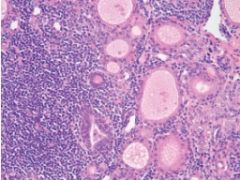![]()
![]()
![]()
Use LEFT and RIGHT arrow keys to navigate between flashcards;
Use UP and DOWN arrow keys to flip the card;
H to show hint;
A reads text to speech;
40 Cards in this Set
- Front
- Back
|
Thyroid hormones
-normal function |
Increase basal metabolic rate and oxygen consumption
-inc. HR and contractility -catabolism of muscle and fat -regulate lipid metabolism -normal growth and development |
|
|
Hypothyroidism
-results in |
-sluggish
-low energy -overweight |
|
|
Canine hypothyroidism
-pathology |
-lymphoplasmacytic thyroiditis
-idiopathic follicular atrophy -congenital uncommon: -secondary -tertiary -iatrogenic |
|
|
2 most common causes of canine hypothyroidism
|
-lymphoplasmacytic thyroiditis
-idiopathic follicular atrophy |
|

Pathology
|
-lymphoplasmacytic thyroiditis
|
|
|
Canine hypothyroidism
-signalment |
-medium age
-possibly more in neutered dogs -Breeds: golden retriever, Doberman, --beagle, borzoi, (lymphoplasmacytic thyroiditis) -- toy fox terrier, rat terrier (congenital hypothyroidism) |
|
|
Canine hypothyroidism
-clinical signs (types) |
-general
-dermatologic -neurologic -cardiovascular -reproductive -ocular -congenital form -myxedema coma |
|
|
Canine hypothyroidism
-general clinical signs |
-lethargy
-mental dullness -weight gain -exercise intolerance -cold intolerance |
|
|
Canine hypothyroidism
-dermatologic clinical signs |
-dry skin
-bilaterally symmetric alopecia (tail, ventrum, trunk) -hyperpigmentation -seborrhea -myxedema -secondary infections |
|
|
Myxedema
-definition |
-deposition of mucopolysaccharides in the skin
|
|
|
Canine hypothyroidism
-neurologic clinical signs |
-peripheral neuropathy (weakness, ataxia, cranial nerve deficits [V, VII, VIII])
-rare central signs (seizure, disorientation, coma) |
|
|
Canine hypothyroidism
-cardiovascular clinical signs |
-bradycardia
-dec. cardiac contractility -atherosclerosis |
|
|
Canine hypothyroidism
-reproductive clinical signs |
Female
-anestrus -uterine intertia -small litters -weak puppies Male -dec. libido -oligospermia -testicular atrophy |
|
|
Canine hypothyroidism
-congenital clinical signs |
-mental dullness
-stunted, disproportionate growth -retained puppy coat |
|
|
Canine hypothyroidism
-Myxedema coma clinical signs |
-rare
-mental depression -hypothermia -non-pitting edema -respiratory depression |
|
|
canine hypothyroidism
-clin path abnormalities |
-mild nonregenerative anemia
-hypercholesterolemia -hypertriglyceridemia |
|
|
Canine hypothyroidism
-diagnostic tests |
-total/free T4
-total/free T3 -TSH -TSH response test -auto-antibodies -adjunctive tests (imaging, biopsy) |
|
|
Types of T4 that can be measured
|
-Total T4
-Free T4 |
|
|
T4 that's metabolically active in tissues
|
-Free T4
|
|
|
T4 test that's better for measuring Canine hypothyroidism
|
-equilibrium dialysis (free T4)
|
|
|
Why is free T4 a better reflection of thyroid status in canine hypothyroidism?
|
less affected by:
-protein levels -drugs -nonthyroidal illness |
|
|
Canine Thyroid Stimulating Hormone (cTSH)
-aka |
-Thyrotropin
|
|
|
cTSH levels in hypothyroid dogs
|
-should be increased due to a lack of negative feedback from T4
combine with TT4 or fT4 |
|
|
Specificity
-define |
-ability to say with certainty that a disease is present
|
|
|
Canine hypothyroidism
-test with the best specificity |
Combo tests
-low TT4 & High TSH -low fT4 & high TSH |
|
|
Canine hypothyroidism
-gold standard diagnostic test |
-TSH Response Test
|
|
|
TSH Response Test
-procedure |
-rhTSH given IV
-TT4 measured 6 hrs later -normal animal should have increased TT4 -hypothyroid should have blunted response $$$$$ |
|
|
Canine hypothyroidism
-types of imaging |
-nuclear scintigraphy
-ultrasound |
|
|
Canine hypothyroidism
-why so difficult to diagnose? |
-nonthyroidal illness (euthyroid sick syndrome) can decrease TT4
-drugs affect thyroid function tests |
|
|
Canine hypothyroidism
-nonthyroidal illnesses that can decrease TT4 |
-hyperadrenocorticism
-diabetic ketoacidosis -hypoadrenocorticism -renal failure -hepatic dz -peripheral neuropathy -heart failure -infection -surgery |
|
|
Should low TT$ be treated in euthyroid sick syndrome patients?
|
-no
-only supplement animals with thyroid illness |
|
|
Canine hypothyroidism
-drugs affecting thyroid function tests |
-glucocorticoids
-anti-epileptics -sulfonamides -NSAIDs -clomipramine -amiodarone, propranolol -heparin -radiocontrast agents |
|
|
Canine hypothyroidism
-treatment |
Levothyroxine supplementation (T4)
-0.1 mg/10 lb PO BID -up to 0.8 mg PO BID (but can go higher for larger dogs) need to monitor after administration because some dogs are very good absorbers and can become hyperthyroid |
|
|
Canine hypothyroidism
-can we supplement with T3 |
-yes, but T4 allows tissues to autoregulate how much is used
|
|
|
Canine hyperthyroidism
-timeline for response to treatment |
-1-2 wks: improved energy
-6-8 wks: weight loss, improved myocardial function -8-12 wks: neurologic resolution -2-6 mo: dermatologic resolution |
|
|
Canine hypothyroidism
-treatment monitoring |
-recheck TT4 in one month
-check TT4 4-6 hrs post levothyroxine pill -TT4 should be normal or slightly high Thyroid supplementation wears off in 1-2 months |
|
|
Canine hypothyroidism
-treatment with myxedema coma |
-supportive care (fluids, passive rewarming, ventilator support)
-levothyroxine 4-5 ug/kg IV BID |
|
|
Canine hypothyroidism
-treatment with concurrent dilated cardiomyopathy |
-supplementation at 25-50% dose
|
|
|
Canine hypothyroidism
-treatment with concurrent hypoadrenocorticism |
-glucocorticoid and mineralocorticoid supplementation first
|
|
|
Feline hypothyroidism
-treatment |
-levothyroxine .05-.1 mg/Cat/day
|

